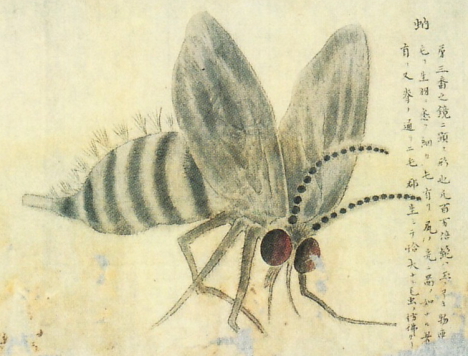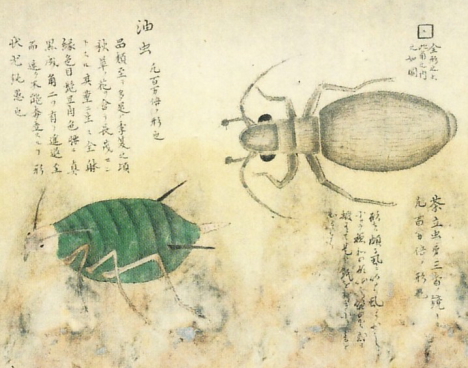Kenbikyo Mushi No Zu ("Illustrations of Microscopic Insects"), a scroll published in 1860, depicts a lively parade of creepy-crawlies as viewed through a microscope. Although most of the insects pictured can actually be seen with the naked eye, the artist's use of a microscope -- still a relatively unusual instrument in Japan in those days -- added a great level of detail to the drawings and made it a rather unique visual work.

Gnat [+]

Mosquito larva [+]

Louse [+]

Flea [+]

Striped mosquito [+]

Silverfish [+]

Aphid (left), Psocid (right) [+]

Fish louse [+]
The first microscope was brought to Japan in the mid-18th century (about 150 years after its invention in Europe) by Dutch traders at Nagasaki, and it was introduced to the public by pharmacologist Rishun Goto in a 1765 book entitled Oranda-banashi ("Story of Things Dutch"). Soon afterward, production of the first Japanese microscopes began in Osaka.
In 1787, Churyo Morishima, a scholar of Western science, published Komo Zatsuwa ("Sayings of the Dutch"), which described the lifestyle and customs of the Dutch in Japan. The document included a section devoted to the microscope, complete with illustrations of insects as seen through the device.
As Japanese microscope technology developed, the device became a popular attraction at carnival sideshows. One notable sideshow in Nagoya in 1820 put an assortment of fleas, lice, mosquitoes and other bugs on public display. According to written records of the event, many spectators shuddered with fear as they peered through the microscopes, which made the creatures look as large as a human hand. Others viewed the microscopes with excitement, as they offered a glimpse into a previously unknown world.
The Tohoku University Library houses the original copy of the Kenbikyo Mushi No Zu scroll.
[See also: Mythical 16th-century disease critters]

bug_girl
The insect you have labeled here as aquatic appears to be a bristletail (Thysanura; also known as a silverfish).
Not aquatic :)
[]Pink Tentacle
Cool, thank you! I only guessed this one might be aquatic because the second kanji character [éš] in the name means "fish." The first kanji is very unusual and the handwriting makes it difficult to read, but thanks to your comment I finally figured out what it was: [è ¹]. Don't know what that kanji means by itself (it does not mean "silver"), but [è ¹éš] does translate as "silverfish" (or "bristletail").
[]bug_girl
Oh, and the first drawing is more likely a gnat than a mosquito.
These are really lovely!
[]Mike
You always manage to find the most bizarre yet fascinating stuff! (At for us lovers of strange creatures and sealife :P) What's your secret to finding it all?
[]Pink Tentacle
No secrets to speak of, but I discovered these old illustrations while perusing the shelves at the local library.
[]robot makes music
While it may be true that the Western world invented microscopes, the principles of magnification were discovered in the Orient. (I mean the true, middle-east orient, not 'oriental' asia) http://en.wikipedia.org/wiki/Microscope
We here in the west tend to trend towards thinking that we have the lock on the scientific method and discoveries, but it's not quite true, just clever historical editing.
Quite amusingly, perhaps, a Dutchman invented the first true microscope; and nearly two hundred years later another brought the invention to Nihon.
And now, they make kick-ass electron microscopes, something they couldn't ever have imagined back then.
[]